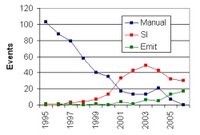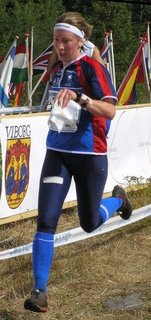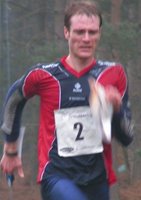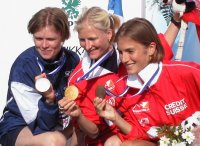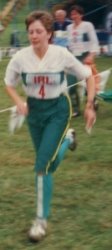 WOC 91
WOC 91 in Czechoslovakia (as it still was then) started early, with a bit of test spectating at the British selection races, held in conjunction with the Scottish 6-Day. I distinctly remember a young Heather Monro having a fairly terrible run and blowing her chance of selection. Despite this she still insisted that the results were changed to spell her name correctly. Her time was yet to come. The other main item of note was a great run from Mark Chapman (a LOKkie like me) which was then ignored by the selectors who left him out of the team. The massed ranks of SHUOC rallied round and the end of the week saw an outbreak of "
Czech Out Chapman" protest t-shirts: civil disobedience comes to orienteering.
This was to be my first trip to Eastern Europe. We did it in style, flying to Nuremburg and driving the short distance to the spa resort of
Marianske Lazne (or Marienbad as it was better known in the West, having starred in some cult movie I hadn't seen) in a friend's black top-of-the-range BMW. This was to be the cause of many envious glances through the week. Spectators had a 3-day event to warm up, in typical hilly and varied terrain. Star attraction at each event was the beer lorry, where a trifling sum bought you a large glass of ice-cold beer to celebrate getting round. We were living it up in real style at the hotel, although the menu left a little to be desired, especially as it was the same every day. Star attraction was the "fried earp" which we worked out was meant to be "fried carp" but normally turned out to be boiled trout if anyone ordered it. Our hotel was just a short stroll from the musical fountains and formal gardens of the main spa area, and altogether it was a very cultured week. We even set out for a day trip to Prague on a rest day, but decided it was too hot and stopped half way. We found a fantastic monastery to visit on a back road, but I've no idea what it was called.
Ironically after all the fuss it turned out that Chappers made the team, since injury forced Steve Hale (I presume it was him) to withdraw. Mark did what only he could by promptly getting disqualified for punching a control on the wrong bush in the short race qualifier. He was in good company, since Yuri Omeltchenko did the same thing. He's another who will feature again soon enough. But it wasn't the disqualifications on the men's course that caused the major row. Instead it was the disqualification of medal hopes Ragnhild Bente Andersen of Norway and Yvette Hague (yes, GB's own superstar), both for punching slightly out of the boxes on the control card. Younger readers will be unfamiliar with the concept of control cards, for the very good reason that the development of electronic punching was a direct result of these disqualifications.
The short race final was based in the grandstand of a horse racing track, and provided little interest to the spectator. Runners emerged from the forest about 400m from the crowd, and proceeded to run across a flat grassy area before finishing. The Brits did nothing in particular, and the main point of interest was double gold for the home runners: almost certainly the first World Championships individual races where a Scandinavian had failed to claim a gold medal.
The classic race returned to normality with Mr Orienteering, Jorgen Martensson of Sweden, claiming gold, even if it was a Hungarian, Katalin Olah, who won the women's race. The courses started with a huge climb out of a river valley, before a slightly less gruelling run around typical rocky outcrops in mixed forest. The spectator race I ran avoided the early climb, but had the same last 12km as the men. IOF guests were less lucky in the traditional IOF race. They got the first, hilly, half of the course instead.
The relays were held near Karlovy Vary (Karlsbad) but I remember little of them. Overall the British week was unspectacular again in terms of results, but the spectator races were better than previous World Championships I had been to. The final memory is of somehow managing to get on the plane home without my passport. I talked my way through immigration at Heathrow on the basis of a London Underground travelcard and three friends wearing identical World Championships t-shirts to mine.
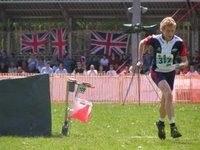 Who is the only British orienteer to have been British M or W21 Champion at Long, Middle, Sprint and Night distances and also won the JK?
Who is the only British orienteer to have been British M or W21 Champion at Long, Middle, Sprint and Night distances and also won the JK?
